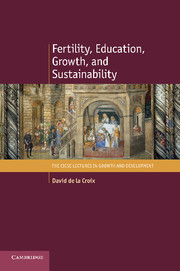Book contents
- Frontmatter
- Contents
- List of figures
- List of tables
- List of symbols
- List of definitions
- List of propositions
- Introduction
- PART ONE DIFFERENTIAL FERTILITY
- 1 Benchmark model
- 2 Implications for the growth–inequality relationship
- 3 Understanding the forerunners in fertility decline
- PART TWO EDUCATION POLICY
- PART THREE SUSTAINABILITY
- Bibliography
- Author index
3 - Understanding the forerunners in fertility decline
from PART ONE - DIFFERENTIAL FERTILITY
Published online by Cambridge University Press: 05 December 2012
- Frontmatter
- Contents
- List of figures
- List of tables
- List of symbols
- List of definitions
- List of propositions
- Introduction
- PART ONE DIFFERENTIAL FERTILITY
- 1 Benchmark model
- 2 Implications for the growth–inequality relationship
- 3 Understanding the forerunners in fertility decline
- PART TWO EDUCATION POLICY
- PART THREE SUSTAINABILITY
- Bibliography
- Author index
Summary
It is one of the universal facts of development that economic growth is accompanied by a demographic transition from high to low fertility. In recent years a number of authors have used economic theory to analyze the interaction between long-run growth and the demographic transition (see Chapter 2). To explain fertility decline during the demographic transition, the majority of these studies relies on the notion of a quantity–quality tradeoff introduced by Becker (1960). In the quantity–quality model, parents choose both the number and “quality” of children, where quality can be interpreted as investments in children, such as education. As the economy grows and wages rise, having many children becomes more costly, since the value of the parents' time increases and children are costly in terms of time. In contrast, rising income implies that investment in education becomes more affordable. Parents therefore substitute child quality for child quantity, and decide to have smaller families with better education. This explanation for the demographic transition is supported by the observation that in many countries average education levels of children were rising significantly during the phase of rapid fertility decline.
The ability to account for fertility both in the cross-section and over time during the demographic transition is one of the key attractions of the quantityquality model. The economic literature on the demographic transition, however, is generally silent on the cross-sectional implications of the fertility model employed.
- Type
- Chapter
- Information
- Fertility, Education, Growth, and Sustainability , pp. 48 - 66Publisher: Cambridge University PressPrint publication year: 2012



